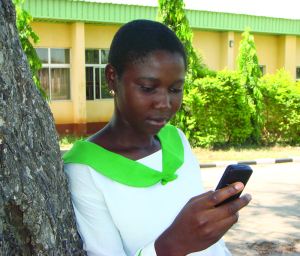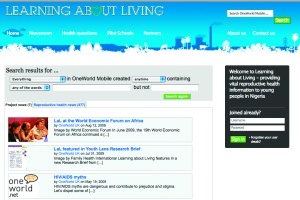TACTIC 9: PLAN YOUR ACTION
TECHNOLOGY THAT LISTENS
let people ask the questions
download this tactic card (pdf 744kb)

ONEWORLD UK/EDUCATION AS A VACCINE AGAINST AIDS
Plan your action
- Find a way to source your information. Infonet's Budget Tracking campaign consisted of government data, data collected by local social development groups and information from text message queries and visitors to the website. In this way Infonet used crowd-sourcing to collect data that helped create new information, as well as to verify existing data.
- Any text message platform you choose will need to be customised in order to meet your users' needs. Some platforms work well for relaying current news by sending the same messages to many people and others are better for providing unique answers to questions asked by different people.
- Working with text messages, data, or voice transmission for mobile phones may require negotiations with telecommunications companies which can be time-consuming and costly. Ask other people in your country how they have achieved this and see which providers may offer a bulk or discount rate to not-for-profit organisations.
- Some information may be better conveyed on websites or spoken through voice services like Freedom Fone. Many campaigns use a combination of methods to maximise reach.
- While tracking, you may be able to ascertain which regions have the greatest participation based on mobile numbers or by using quick surveys sent via text message.
Do it yourselfAsk
- How will you collect the data you will be making available to people, and what sources can you trust?
- Will you permit people to add their own data to your campaign?
- Is there an out-of-the-box tool you can use to collect queries and transmit information, or will you need to create a tool of your own?
- What’s your media/outreach plan to maximise participation?
- Is there a timely event that your campaign can connect with to encourage more people to pay attention to your issue?
- In addition to putting needed facts in people’s hands, is there a target, (a person or organisation) who can make the change you want to see, that you can ask people to speak to directly?
- Your campaign may involve collecting and broadcasting sensitive information over telecommunications networks. What security and privacy concerns exist and how will you address them?
Different ways you can do this
- To prevent users being charged for mobile messages to you, you can buy a short code from a telecommunications provider. Short codes are designed to be shorter and easier to remember than normal mobile numbers. Shared short codes can be much more affordable than dedicated numbers.
- To engage audiences where a straightforward question-and-answer approach may not be persuasive, you can offer information in the form of entertaining and educational quizzes.
- Pose a question on a controversial topic and collect opinions through text or voice messages. In response, send back a fact or a resource to connect your audience to more information.
- If you get consent from people, you can use their contact information to re-connect with them for future actions.
- At an action or demonstration, ask supporters to send a text message if they would like you to send them alerts during the action: about police activity, safety measures they can take, and legal or medical support.
|
FEATURED TOOL Create a free call-in centre and interactive voice menu system FreeSwitch is a free, open source software system that allows you to give people information through voicemail and interactive voice response menus. Once installed, you can create interactive voice response (IVR) menus, and the system will respond to unique questions spoken by users or typed on their phone's keypad. The IVR gives people answers that you have programmed it to – either dynamically based on the question or pre-recorded. |
TIPS BRENDA BURRELL OF KUBATANA, ON MOBILES: "The largest growing technology tool in use in the world is the mobile phone, particularly in the developing world where mobiles have become the tool of communication of the ordinary person. People have focused on text messaging for campaigns, but there are a lot of other things that we can do to innovate."
UJU OFOMATA OF MYQUESTION, MY ANSWER, ON CONNECTING PEOPLE ACROSS PLATFORMS: "In our campaign, text, voice and the web were all connected – some questions can’t be answered in the 160 characters that text messages are limited to. Sometimes we ask people to call a toll-free line so they can speak directly to us. You might need to probe a bit more before giving someone the right answer."
EVAN 'RABBLE' HENSHAW-PLATH, TECHNOLOGIST, ON THE POWER OF VOICE: "Text messaging seems like a technology of the developing world but it's also important to realise that people use mobile phones for actual phone calls. The phone used to be something that was controlled by the telecommunications monopolies and over the last few years there has been a whole renaissance in telephony that has seen voice services built over the internet. You can now run your own phone company on free software." |
TACTIC 9: CASE STUDY
TECHNOLOGY THAT LISTENS
let people ask the questions
download this tactic card (pdf 744kb)

Case Study
| TITLE: WHO: WHERE: WEBSITE: |
MyQuestion, MyAnswer OneWorld UK/Education as a Vaccine Against AIDS Nigeria Oneworld Mobile |
DESCRIPTION
Young people in Nigeria face obstacles in getting accurate sexual and reproductive health information, due to stigma and taboos. A collaboration between OneWorld UK and local NGO, Education as a Vaccine Against AIDS, produced 'MyQuestion/MyAnswer,' a mobile phone campaign that lets young people take control over their own sexual health education anonymously and securely. 'MyQuestion/MyAnswer' relies on its audience's familiarity with mobile phones and the sense that the information they get on their mobiles is private and will not be judged by adults. Questions may be sent in via text message and responses can include health facts, links to local clinics, or a chance to speak directly by phone to a counsellor. The questions are later aggregated into a frequently-asked questions database. "Getting someone to talk to them straight – that was the most important thing," says project manager Uju Ofomata. "Then getting people to use the service wasn’t a problem." Nearly 60,000 questions have been sent to the service in its first two years.
| TOOLS USED: | mobile platform customised from open source software (Apache web server, PHP application, MySql database), website, mobile phones. |
| REACH: | National, with a concentration of users in urban and suburban settings and a majority in southern Nigeria. |
| RESOURCES: | Local partners, press campaign. By partnering with a local NGO with extensive experience working locally with young people, the campaign was regarded as trusted and reliable. A major press campaign, in print news, radio, and television media spread information about the service to young people. |
| TIME: | Five months to build and launch the mobile platform. The negotiations with the telecom companies took at least three months. Project ongoing. |
LEVEL Of DIFFICULTY: 4 out of 5
COST: USD$30,000 for telecom costs, USD$10,000 for publicity, USD$60,000 for salary and project management.
LINKS TO LEARN MORE:
